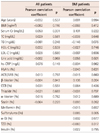1. Baenziger NL, Brodie GN, Majerus PW. A thrombin-sensitive protein of human platelet membranes. Proc Natl Acad Sci U S A. 1971. 68:240–243.
2. Bornstein P. Diversity of function is inherent in matricellular proteins: an appraisal of thrombospondin 1. J Cell BIol. 1995. 130:503–506.
3. Adams JC. Thrombospondins: multifunctional regulators of cell interactions. Annu Rev Cell Dev Biol. 2001. 17:25–51.
4. Ren B, Yee KO, Lawler J, Khosravi-Far R. Regulation of tumor angiogenesis by thrombospondin-1. Biochim Biophys Acta. 2006. 1765:178–188.
5. Agah A, Kyriakides TR, Lawler J, Bornstein P. The lack of thrombospondin-1 (TSP1) dictates the course of wound healing in double-TSP1/TSP2-null mice. Am J Pathol. 2002. 161:831–839.
6. Frangogiannis NG, Ren G, Dewald O, et al. Critical role of endogenous thrombospondin-1 in preventing expansion of healing myocardial infarcts. Circulation. 2005. 111:2935–2942.
7. Isenberg JS, Romeo MJ, Abu-Asab M, et al. Increasing survival of ischemic tissue by targeting CD47. Circ Res. 2007. 100:712–720.
8. Stenina OI, Krukovets I, Wang K, et al. Increased expression of thrombospondin-1 in vessel wall of diabetic zucker rat. Circulation. 2003. 107:3209–3215.
9. Raman P, Krukovets I, Marinic TE, Bornstein P, Stenina OI. Glycosylation mediates up-regulation of a potent antiangiogenic and proatherogenic protein, thrombospondin-1, by glucose in vascular smooth muscle cells. J Biol Chem. 2007. 282:5704–5714.
10. Murphy M, Godson C, Cannon S, et al. Suppression subtractive hybridization identifies high glucose levels as a stimulus for expression of connective tissue growth factor and other genes in human mesangial cells. J Biol Chem. 1999. 274:5830–5834.
11. Tada H, Kawai H, Ishii H, Nomura K, Urayama T, Isogai S. Thrombospondin modulates adhesion, proliferation and production of extracellular matrix in mesangial cells. Tohoku J Exp Med. 1995. 177:293–302.
12. Poczatek MH, Hugo C, Darley-Usmar V, Murphy-Ullrich JE. Glucose stimulation of transforming growth factor-beta bioactivity in mesangial cells is mediated by thrombospondin-1. Am J Pathol. 2000. 157:1353–1363.
13. Yevdokimova N, Wahab NA, Mason RM. Thrombospondin-1 is the key activator of TGF-beta1 in human mesangial cells exposed to high glucose. J Am Soc Nephrol. 2001. 12:703–712.
14. Belmadani S, Bernal J, Wei CC, et al. A thrombospondin-1 antagonist of transforming growth factor-beta activation blocks cardiomyopathy in rats with diabetes and elevated angiotensin II. Am J Pathol. 2007. 171:777–789.
15. Report of the Expert Committee on the diagnosis and classification of diabetes mellitus. Diabetes care. 1997. 20:1183–1197.
16. Chobanian AV, Bakris GL, Black HR, et al. The seventh report of the joint national committee on prevention, detection, evaluation, and treatment of high blood pressure: the JNC 7 report. JAMA. 2003. 289:2560–2572.
17. Gensini GG. A more meaningful scoring system for determining the severity of coronary heart disease. Am J Cardiol. 1983. 51:606.
18. Majack RA, Goodman LV, Dixit VM. Cell surface thrombospondin is functionally essential for vascular smooth muscle cell proliferation. J Cell Biol. 1988. 106:415–422.
19. Stouffer GA, Hu Z, Sajid M, et al. Beta3 integrins are upregulated after vascular injury and modulate thrombospondin- and thrombin-induced proliferation of cultured smooth muscle cells. Circulation. 1998. 97:907–915.
20. Kirma C, Akcakoyun M, Esen AM, et al. Relationship between endothelial function and coronary risk factors in patients with stable coronary artery disease. Circ J. 2007. 71:698–702.
21. Hsu SC, Volpert OV, Steck PA, et al. Inhibition of angiogenesis in human glioblastomas by chromosome 10 induction of thrombospondin-1. Cancer Res. 1996. 56:5684–5691.
22. Nör JE, Mitra RS, Sutorik MM, Mooney DJ, Castle VP, Polverini PJ. Thrombospondin-1 induces endothelial cell apoptosis and inhibits angiogenesis by activating the caspase death pathway. J Vasc Res. 2000. 37:209–218.
23. McGillicuddy FC, O'Toole D, Hickey JA, Gallagher WM, Dawson KA, Keenan AK. TGF-beta1-induced thrombospondin-1 expression through the p38 MAPK pathway is abolished by fluvastatin in human coronary artery smooth muscle cells. Vascul Pharmacol. 2006. 44:469–475.
24. Topol EJ, McCarthy J, Gabriel S, et al. Single nucleotide polymorphisms in multiple novel thrombospondin genes may be associated with familial premature myocardial infarction. Circulation. 2001. 104:2641–2644.
25. Yamada Y, Izawa H, Ichihara S, et al. Prediction of the risk of myocardial infarction from polymorphisms in candidate genes. N Engl J Med. 2002. 347:1916–1923.
26. Carlson CB, Liu Y, Keck JL, Mosher DF. Influences of the N700S thrombospondin-1 polymorphism on protein structure and stability. J Biol Chem. 2008. 283:20069–20076.
27. Stenina OI. Regulation of vascular genes by glucose. Curr Pharm Des. 2005. 11:2367–2381.
28. Selvin E, Marinopoulos S, Berkenblit G, et al. Meta-analysis: glycosylated hemoglobin and cardiovascular disease in diabetes mellitus. Ann Intern Med. 2004. 141:421–431.









 PDF
PDF ePub
ePub Citation
Citation Print
Print


 XML Download
XML Download